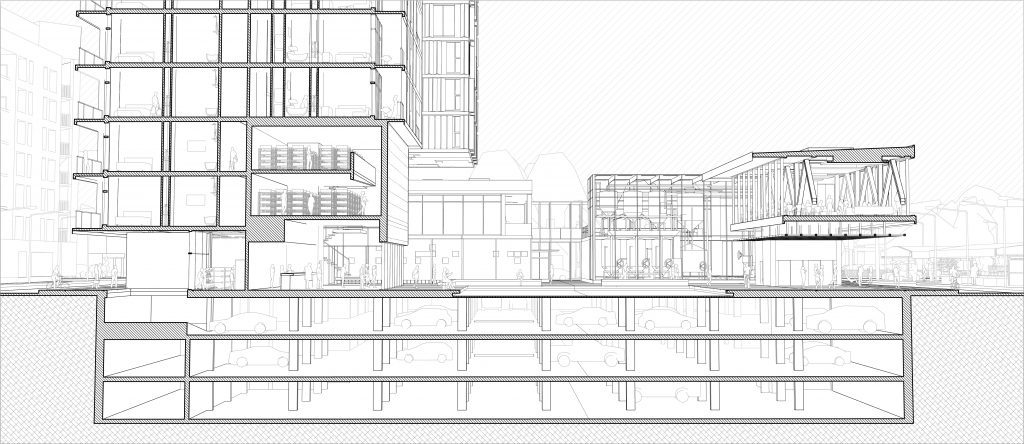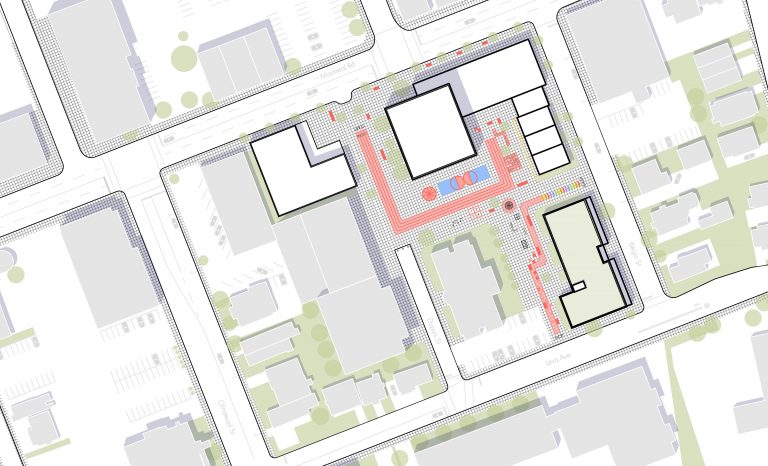Winners of the 2023 Hobin Prize in Architecture & City Building
February 5, 2023
Three Carleton University student projects that explore the potential of high-density urban housing on sites in Ottawa have received a Hobin Prize in Architecture & City Building.
Hobin Architecture, an Ottawa firm that devotes much of its energy to urban residential buildings, established the prize in 2019 to recognize outstanding work in the fourth-year housing studio at the Azrieli School of Architecture & Urbanism.
The studio brings together students from all three undergraduate majors – Design, Urbanism, Conservation, and Sustainability.
“The prize supports the school’s commitment to urbanism and its efforts to frame architecture in the context of the larger physical and social environment,” says Associate Professor Benjamin Gianni, who conceived the studio and leads it.
“Architecture has an important role in orchestrating the interaction between diverse groups of people and different uses,” says Gianni. “The closer together that we live, the more design matters.”
Students typically worked in pairs, developing the urban design collaboratively and then making individual proposals for selected buildings that would be part of the larger development.
The jury considered 13 projects nominated by the five professors and instructors who taught the studio in Fall of 2022: Benjamin Gianni, Sheryl Boyle, Honorata Pienkowska, Eric Archambault, and Piper Bernbaum.
First Prize ($2,500)
Parkdale Pocket
Aniko Nebozuk and Bryan Ye
Student Description: The Parkdale Pocket is a residential-commercial complex aiming to revitalize Hintonburg by reviving existing elements on the site. The heritage-protected tavern was not only preserved but extended by including a brewery. Connected behind the pub is a bathhouse paying homage to one demolished in the 1920s. To the west is a reading room and courtyard that allows the Parkdale Market to extend onto the site. At the centre of the courtyard is a recessed square that transforms from a summer fountain to a drained movie theatre seating area to a winter skating rink. Atop sit two residential towers connected through a shared circulation tower, allowing residents to share common spaces such as the rooftop gardens and gym.
Jury Comments: The one that stood out the most for us was about city building and placemaking. It hit a lot of the marks we were looking for. It had a great urban edge. The extension of the market was fantastic. Elevating the amenity spaces off the ground floor plane creating that central courtyard area was a great idea. We loved the idea of preserving, the pub and the bathhouse.


Second Prize ($1,500)
Brick Commons
Amra Alagic and Mouhamad Jamili
Student Description: Brick Commons aims to be a housing community that accommodates a wide range of age groups and abilities. The prominence of brick within the project is heavily influenced by the surrounding facades along Montreal Road and within the greater community. The durability of brick cladding allows for a cost-effective group of buildings that can withstand the realities of play. This housing project offers unit sizes ranging from studio apartments to four-bedroom apartments. Vibrant communities are often diverse, and the mix of children, adults, and elders on this site is something the project wishes to invite.
Jury Comments: Some of the successful points of this project: Creating a vibrant space that’s family and community oriented, the texture on the ground plane and the position of the buildings and the draw from Montreal Road to the centre courtyard space.


Third prize ($1,000)
Deerfield Living
Nana Fukumoto and Simon Martignano
Student Description: Deerfield Living is a study on balanced densification. By altering the current street layout and giving consideration to building placement, the designers were able to triple the number of units while accommodating a balance of residents and unit types. By expanding the park at the centre of the site, most of the mature trees have been preserved. The repeating chevron-shaped buildings on the east side of the site increase in scale to maximize views into the park. The Silk, a classic podium tower on the corner of two major streets, was inspired by a silk curtain. Both building types incorporate family-friendly units at grade, with apartments above.
Jury Comments: It had the strongest master plan, a sense of an urban place, a centre to it.


The awards ceremony took place on February 2 in the PIT at the Architecture Building.
The students presented their projects to the five-member jury, which included three alumni of the school who are part of Hobin Architecture: Gordon Lorimer, Rheal Labelle, and Marc Thivierge. Also on the jury were Director Anne Bordeleau and Assistant Professor Jerry Hacker.
“I am very impressed by the level of thinking and resolution that went into all these sites,” said Bordeleau. “It was really amazing work all around.”
About the Studio
For the past decade, the fourth-year housing studio has partnered with local developers to explore sites in Ottawa that are likely to redevelop. Most of these sites are in areas that the City of Ottawa has targeted for intensification.
“As such, students are challenged to not only accommodate more residents but propose designs that respect, complement, and enhance the neighborhoods in which they are located,” says Gianni. “Special emphasis is given to preserving social diversity, minimizing displacement, and enhancing the public realm.”
This year, the school was privileged to work with three partners: two for-profit developers — Taggart Realty and Minto Communities — and a not-for-profit indigenous housing provider, Gignul Non-Profit Housing Corporation.
In conjunction with each of the partners, the studio selected three sites.
• A city block in Hintonburg bounded by Parkdale Avenue to the east, Armstrong Street to the south, Spencer Street to the north and Hamilton Avenue to the west
• A large complex of rental housing in Ottawa close to an LRT station
• A lot at 250 Montreal Road in Vanier
Students working with Gignul were challenged to include market housing along with social housing, while those working with Taggart and Minto were required to incorporate not-for-profit housing with market units.
“In so doing, students had to pay close attention to affordability and consider what role architecture might play in addressing interactions between diverse demographics,” says Gianni.
As a comprehensive studio for upper-level undergraduates, students are required to work through all phases of the project, including site and neighborhood analysis, master planning, the detailed design of specific buildings, and technical detailing of building envelopes.